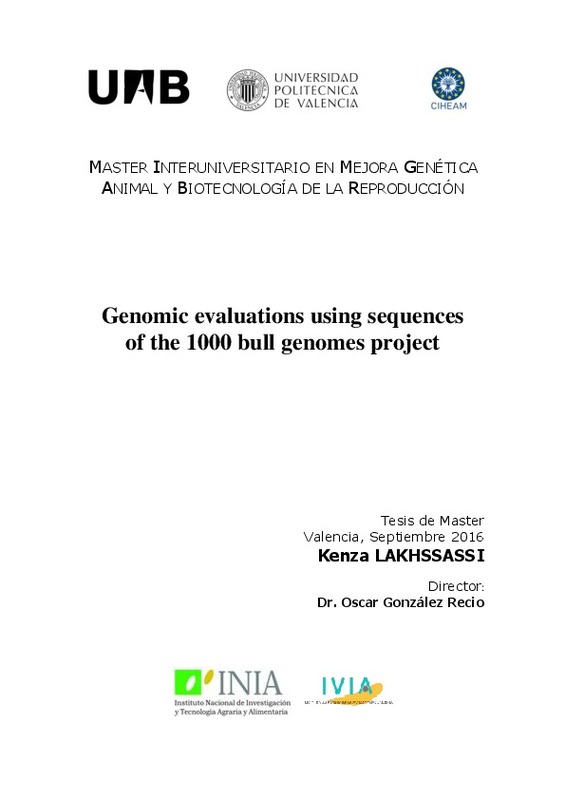|
Resumen:
|
[EN]
regression
approach
for
genetic evaluation using
population
sample of 450
Holstein
animals
,
with full
-
sequence data from
the
1000 bull genomes project
is p
resented
in this thesis
.
This ...[+]
[EN]
regression
approach
for
genetic evaluation using
population
sample of 450
Holstein
animals
,
with full
-
sequence data from
the
1000 bull genomes project
is p
resented
in this thesis
.
This approach is based on
the assumption that haplotypes
from sequencing
data
are in strong
er
li
nkage disequilibrium (LD) with Quantitative Trait L
oci (QTL) than
marker
s from
SNP chips
. This study focuses
on
the extraction
of haplo
types in the
population
and their incorporation
in the whole sequence prediction model
. In total,
38,319,
258 SNPs (and indels) from
Next G
eneration Sequencing (
NGS
)
were included.
V
ariants
with
Minor Allele Frequency (
MAF<
0.025
)
were discarded
leading a t
otal of
13
,
912
,
326
SNPs
available for the analyses
.
H
aplotypes were obtained from version 3 of
findfhap.f90
software
.
The number of SNPs
in the
haploblock
s
ranged from 79
9 in BTA 13
to 1285
in BTA 12
, with a mean
of 924
SNP
(
166
,
552
pb).
The h
aplotypes wit
h a frequency below
1% were around 97% in all
chromosomes
.
These haplotypes
were ignored leaving
1
53
,
428
haplotypes for
subsequent
analys
e
s
.
Each haplotype was identified
by
chromosome and segment where it is located
as well as
the ordered
number
of the ha
plotype within the segment. The haploblocks were
then used to predict four economically important traits: kg of
protein
(Prot)
, Global Type
Index (IGT), Somatic Cell
Score
(
S
C
S
)
and Days Open (DO). The phenotypic values
were the MACE proofs
provided by
the
Spanish Holstein Association CONAFE. The
phenotypic data were merged with the haplotype file
and a Bayesian model was
implemented to predict G
enomic
E
stimated
B
reeding
V
alue (GEBV)
.
E
stimated
h
aplotypes
had a large
contribu
tion to
the total variance of
GEBV
(
between
3
2
and
99.9
%
).
Most of
the haplotypes
for Prot, IGT and DO
have low
-
intermediate frequencies
while haplotypes
found for SCS are
mostly
at low frequencies. We expect that these
haplotypes will
give us additional information
to SNP genotypes on
those
less common
variants
, as SNP b
eadchips are designed to genotype intermediate
-
high MAF
.
In order to
reduce the number of haploblocks neede
d to perform genomic prediction
,
a
subsets of haploblocks
that
contain
ed
haplotypes with large effects
were selected.
A total
of 1264 haplotype
s
exce
eded the genome wide threshold
of 3
standard deviation
(sd)
above mean (in absolute value)
for Prot, 1909 for IGT, 851 for SCS and 1450 for DO
distributed along the genome.
In the second criterion
,
those with effect estimate (in
absolute value) larger than
1
s
d
above mean
which
led
to a
total of 44
,
319
haplotype
s
f
or
20
Prot, 39
,
975 for IGT, 46
,
132 for SCS
and
42
,
878
for DO
. Then,
haplotypes
selected in
each criteria
were subjected to
a new
analysis.
The proportion of the genetic variance esti
mated values corresponding to the haplotypes
effect was
1.06, 5.24, 15.29
and
11.64%
for
Prot, IGT, SCS
and
DO
,
respectively
, using
the first criterion (
3
sd
)
and
10.92, 33.30
and
53.93
%
for
Prot, SCS
and
DO
,
respectively
,
using the second
criterion
(1
sd
)
.
Genomic predictions using only a set of app
ropriately selected haploblocks
can provide
additional information
to
GEBV
prediction
, and should be considered in more in
-
depth
[-]
[ES] El objetivo de este trabajo sería el desarrollo de estrategias que incorporen
información de secuencias en las evaluaciones genéticas. Para ello se utilizarán las
secuencias del consorcio de los 1000 genomas bovinas. ...[+]
[ES] El objetivo de este trabajo sería el desarrollo de estrategias que incorporen
información de secuencias en las evaluaciones genéticas. Para ello se utilizarán las
secuencias del consorcio de los 1000 genomas bovinas. Se evaluará la capacidad
predictiva de esta información y se comparará con la obtenida utilizando chips de
SNPs de alta densidad. Durante el periodo de investigación se prevé que el alumno/a
desarrolle además conocimientos de programación en fortran, R y/o java.
[-]
|







